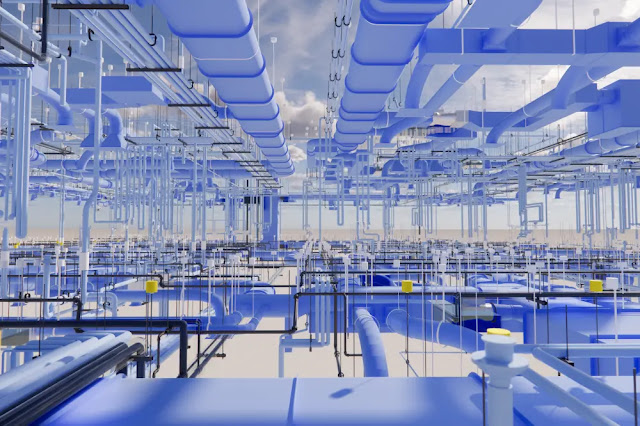Building
projects, paying little mind to estimate or intricacy, require exact
preparation and coordination among different disciplines. Frameworks for
mechanical, electrical, and plumbing (MEP) make up the groundwork of a
building. MEP is a basic part in the general plan of a building project. It
incorporates each component that ensures productivity, solace, and security.
We'll go over the essentials of MEP plans and their significance in development
projects in this article.
What are MEP
Plans?
MEP plans
are careful, specialized reports that portray a building's pipes, electrical,
and mechanical frameworks. These plans incorporate the plan, establishment, and
upkeep of the MEP frameworks and guarantee they cooperate consistently. The
goal is to conform to all pertinent development regulations and guidelines
while making a space that is protected and agreeable for occupants.
The
mechanical part of MEP includes warming, ventilation, and cooling (central air)
frameworks, as well as different frameworks like refrigeration, lifts, and
lifts. These frameworks manage the building's inside climate, guaranteeing a
steady and agreeable environment.
The
electrical angle covers the plan and establishment of wiring, lighting, power
dispersion, alarms, and media communications frameworks. Electrical frameworks
are critical for the activity of each and every building, making up one of the
most fundamental pieces of MEP plans.
Plumbing
incorporates water supply, seepage, and sewage frameworks, as well as
particular frameworks like water radiators, siphons, and sprinklers for fire
security. The viability of waste assortment and water stream are ensured by a
very much planned plumbing framework.
Importance
of MEP Design in Building Projects
All the
mechanical, electrical, and plumbing work that should be finished on a
development project is illustrated in MEP plans. They guide the workers for
hire and architects, guaranteeing that all frameworks are introduced
appropriately, capability effectively, and follow neighborhood guidelines.
These plans assume a part in:
By
incorporating every one of the important frameworks all along, MEP plans
forestall exorbitant mix-ups during development. They permit various project
workers and groups to work in an organized way, staying away from clashes and
covers between frameworks. This effective arranging lessens deferrals,
blunders, and extra costs.
Explicit
building standards and principles that oversee the plan and establishment of
MEP frameworks should be trailed by each building. MEP plans guarantee
consistence by giving point by point data about the building's frameworks,
forestalling exorbitant lawful issues or the requirement for alterations later
on.
A very much
planned MEP plan thinks about the building's energy use, expecting to lessen
utilization and lower working expenses. Current air conditioning frameworks,
for instance, can be made to consume less energy while as yet offering adequate
warmth and ventilation. Moreover, plumbing frameworks can be upgraded to limit
water squander. MEP frameworks are key parts in green building plan and LEED
(Authority in Energy and Natural Plan) accreditation endeavors.
The solace
and wellbeing of building tenants to a great extent rely upon the legitimate
working of MEP frameworks. For instance, central air frameworks keep up with
agreeable temperatures, electrical frameworks give sufficient lighting and
power, and plumbing frameworks guarantee a perfect water supply and effective
garbage removal. MEP plans guarantee these frameworks cooperate flawlessly to
give a protected and agreeable climate.
Key Elements
of MEP Plans
Mechanical
plans incorporate the design of air conditioning frameworks, ventilation work,
hardware areas, and air dealing with units. These plans are fundamental for
controlling wind stream, temperature, and moistness inside the building.
Legitimate mechanical arranging additionally addresses contemplations like
intensity misfortune, air quality, and energy effectiveness.
Electrical plans are point by point designs of the relative multitude of electrical parts, including lighting, electrical plugs, wiring, and control frameworks. They additionally map out security highlights like alarms, smoke alarms, and crisis frameworks.
Water supply
lines, squander waste frameworks, and apparatuses like sinks, latrines, and
showers are undeniably spread out in plumbing designs. They additionally
incorporate more intricate frameworks, like water system, fire concealment, and
gas funneling. Plumbing plans guarantee the building's water frameworks are
solid, clean, and satisfy wellbeing and security guidelines.
Coordination
Among MEP Systems
Perhaps of
the greatest test in making MEP plans is guaranteeing that all frameworks
cooperate without impedance. For example, mechanical frameworks frequently
include huge gear that might occupy significant room, which can struggle with
electrical wiring or plumbing lines. MEP engineers should cautiously arrange
their plans to forestall such struggles and guarantee that all frameworks fit
into the assigned spaces inside the building.
MEP
engineers work intimately with planners and primary specialists to dispense
space for mechanical, electrical, and plumbing frameworks. This cooperation
guarantees that all parts fit inside the building without slowing down its
design or feel. For instance, central air channels might have to run close by
plumbing pipes and electrical conductors, requiring cautious wanting to
forestall crashes.
Appropriate
booking is fundamental for the fruitful execution of MEP frameworks. Since
numerous frameworks rely upon each other (e.g., electrical frameworks fueling
central air hardware), MEP plans incorporate definite timetables and stages for
establishment. This guarantees that one framework's establishment doesn't ruin
the work on another.

No comments:
Post a Comment